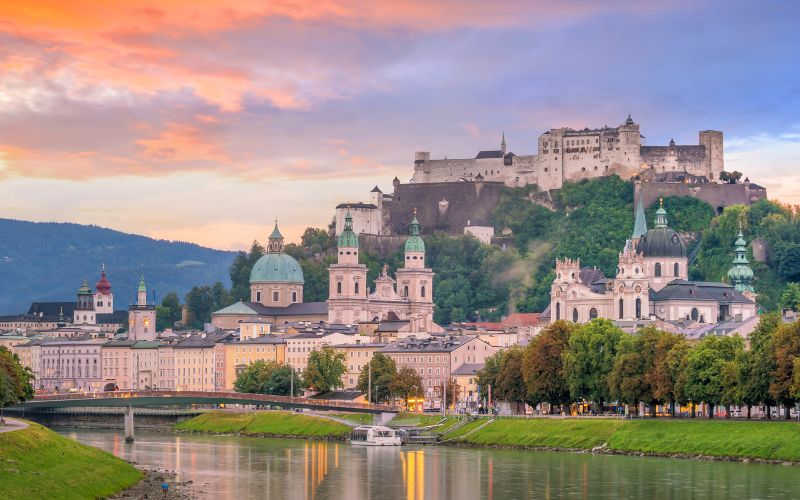7 Historical Sites in Austria That Will Transport You Back in Time
Austria, a country renowned for its stunning landscapes and rich cultural heritage, is home to a plethora of historical sites that offer a window into its glorious past. From magnificent palaces to ancient castles, each site tells a story of the emperors, artists, and ordinary people who shaped this remarkable nation. With its blend of baroque architecture, Gothic cathedrals, and medieval fortifications, Austria’s historical landmarks not only reflect the artistic achievements of different eras but also serve as symbols of the country’s enduring legacy.
Visitors to Austria will find themselves immersed in history as they explore iconic sites like Schönbrunn Palace, the grandeur of Hohensalzburg Fortress, and the solemnity of Mauthausen Concentration Camp. These locations provide an opportunity to reflect on Austria’s multifaceted identity, shaped by centuries of political, cultural, and social influences. Each visit promises a unique experience that will transport you back in time, allowing you to appreciate the beauty and complexity of Austria’s historical narrative.

Here are some historical sites in Austria that will transport you back in time.
1. Schönbrunn Palace

Schönbrunn Palace, located in Vienna, is one of Austria’s most iconic landmarks and a UNESCO World Heritage Site. Once the summer residence of the Habsburg emperors, this baroque masterpiece boasts over 1,400 rooms, lavish gardens, and stunning fountains. Visitors can explore the opulent state rooms, including the Great Gallery and the Hall of Mirrors, which showcase the grandeur of imperial life. The palace gardens feature intricate landscaping, walking paths, and the famous Gloriette, which offers panoramic views of Vienna. A visit to Schönbrunn is a glimpse into Austria’s royal history and the luxurious lifestyle of its former rulers.
2. Hohensalzburg Fortress

Perched atop the Festungsberg hill, Hohensalzburg Fortress is one of the largest and best-preserved medieval castles in Europe. Constructed in the 11th century, this imposing fortress provides breathtaking views of Salzburg and the surrounding Alps. Visitors can explore the fortress’s well-preserved interiors, including the state rooms and the medieval chapel. The fortress also houses several museums, showcasing artifacts from its storied past. A guided tour or audio guide enhances the experience, allowing visitors to learn about the fortress’s history and its role in protecting Salzburg from invasions. The journey up to the fortress can be made on foot or via a funicular, making it an accessible and rewarding destination.
3. Melk Abbey
architecture and a UNESCO World Heritage Site Melk Abbey, located on the banks of the Danube River, is a stunning example of baroque. Founded in the 11th century, this Benedictine monastery boasts a rich history and a breathtaking setting. Visitors can explore the abbey’s magnificent library, adorned with intricate frescoes and housing thousands of ancient texts. The church, with its lavish interior and stunning altar, is a highlight of any visit. The gardens surrounding the abbey offer serene views of the river and the picturesque landscape, making Melk Abbey a perfect blend of history, spirituality, and natural beauty.
4. The Vienna State Opera
The Vienna State Opera, or Wiener Staatsoper, is one of the most prestigious opera houses in the world, renowned for its remarkable architecture and exceptional performances. Opened in 1869, this neo-Renaissance building is an architectural gem with its grand façade and lavish interiors. Guided tours provide insight into the opera’s history, the production process, and the impressive artistry of its performances. Attending a show at the Vienna State Opera is a unique experience, allowing visitors to witness the magic of live opera in a venue steeped in artistic heritage. The opera house is a testament to Austria’s deep-rooted passion for music and performing arts.
5. St. Stephen’s Cathedral
Located in the heart of Vienna, St. Stephen’s Cathedral (Stephansdom) is a masterpiece of Gothic architecture and an enduring symbol of the city. The cathedral’s stunning façade, adorned with intricate sculptures, and its iconic tiled roof make it a must-visit site. Inside, visitors can marvel at the ornate altars, impressive stained-glass windows, and the striking pulpit. Climbing the tower offers a panoramic view of Vienna’s skyline, rewarding those who make the ascent. St. Stephen’s Cathedral has witnessed many significant historical events and remains a focal point of Vienna’s cultural and religious life.
6. The Mauthausen Concentration Camp Memorial
The Mauthausen Concentration Camp Memorial serves as a somber reminder of Austria’s history during World War II. Located near Linz, this site was one of the most notorious concentration camps, where thousands of prisoners endured harsh conditions and brutality. The memorial offers guided tours and exhibits that educate visitors about the camp’s dark past and the experiences of those who suffered there. Walking through the camp grounds, visitors can pay their respects and reflect on the importance of remembrance and the lessons learned from history. The Mauthausen Memorial is an essential visit for those seeking to understand the impact of the Holocaust and the resilience of the human spirit.
7. Innsbruck’s Golden Roof
Innsbruck’s Golden Roof (Goldenes Dachl) is a landmark that represents the city’s medieval history and architectural beauty. Built in the 15th century, this ornate balcony features a roof covered with 2,657 gilded copper tiles, which gleam in the sunlight. It was constructed for Emperor Maximilian I, who used it to watch tournaments and festivities in the square below. The surrounding Old Town, with its charming narrow streets and colorful buildings, invites visitors to explore further. The Golden Roof serves as a symbol of Innsbruck’s rich history and its significance as a center of trade and culture during the Middle Ages.
Conclusion
In conclusion, Austria’s historical sites are a testament to its rich heritage and cultural significance. Exploring these landmarks allows visitors to step back in time and experience the grandeur of its imperial past, the resilience of its people, and the artistry that defines this remarkable nation. From the opulent halls of Schönbrunn Palace to the haunting memorials at Mauthausen, each site offers a unique insight into Austria’s diverse history, making it a compelling destination for history enthusiasts and casual travelers alike.
To fully immerse yourself in this enchanting experience, consider booking one of the many Austria tour packages from Dubai or Austria holiday packages available. These packages often include guided tours, accommodation, and transportation, ensuring a seamless journey through Austria’s historical landscape. Whether you are wandering through the cobbled streets of Vienna, exploring the charming towns of Salzburg, or discovering the ancient fortresses that dot the countryside, these carefully curated experiences will help you create unforgettable memories in a land where history comes alive.











Post Comment